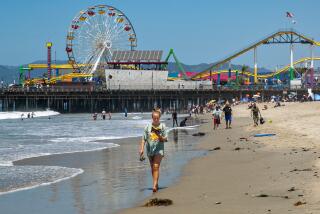On Southland piers, warning that more fish species are tainted
Every weekend anglers stream to piers along Los Angeles County’s beachfront, cast their lines into the ocean and plop fish into buckets and coolers to take home to eat.
It’s no secret that some of the fish they catch, including the abundant white croaker, are so tainted by lingering pesticides and other pollutants that they should never be eaten. For many, though, it’s a meal and caution is thrown to the wind.
But now, after an exhaustive scientific study and a new health advisory, authorities are asking pier anglers to be more discriminating and warning them that the number of fish on the “do not eat” list has expanded from one to five species.
In the so-called red zone that reaches from Santa Monica to Seal Beach, four fish besides the white croaker — barracuda, topsmelt, black croaker and barred sand bass — are now considered so contaminated with the long-banned pesticide DDT, PCBs and mercury that they too are unsafe to eat. Scientists say the expanded list isn’t a sign that pollution has worsened, but rather an indication that they better understand the extent of the contamination.
Next month, health officials plan to install signs at two dozen piers and fishing spots that will warn anglers to throw back those fish.
Pier anglers, mostly low-income Latinos and Asians from inland communities who take to the piers as a cheap diversion and a way to supplement their diet, are slowly adapting to the guidelines, though some are unaware that eating fish with elevated levels of the toxic substances can lead to cancer, developmental problems and neurological damage.
The environmental nonprofit Heal the Bay, one of the groups working under a U.S Environmental Protection Agency program, has been visiting piers to get the word out. Bilingual outreach workers pass out information cards with illustrations of the toxic fish.
Frank Franco, 15, goes fishing every Saturday at Belmont Pier in Long Beach with his dad and can spout off the list of the hazardous five. Nonetheless, if he catches a sand bass, he keeps it “because it’s big and it’s good food.”
“Yes, it’s contaminated, but I’ll eat it as a filet every few weeks,” he said. “If you eat it every night, it’s something else.”
Much of the contamination stems from actions by Montrose Chemical Corp., which operated the nation’s largest DDT manufacturing plant. From the late 1940s to the early ‘70s, the company dumped about 110 tons of the pesticide and 11 tons of PCBs into sewers that poured into the ocean off the Palos Verdes Peninsula’s White Point. Both chemicals were banned in the ‘70s.
The EPA declared a huge expanse of the Palos Verdes Shelf a Superfund site, ranking the deposit of contaminated sediment that extends over 17 square miles offshore as one of the most hazardous dumping grounds in the nation. In 2009, the agency decided to move forward with a partial solution: burying the most contaminated 300 acres of the seafloor with sand and silt to reduce health risks.
White croaker, a bottom-feeder that accumulates DDT and PCBs in its fatty flesh, has been under a “do not consume” advisory since 1991 and remains the most contaminated species along the Los Angeles and Orange County coasts.
The list grew in 2009 after federal scientists spent nearly seven years studying how contaminants have accumulated in fish off Southern California.
Two of the fish — topsmelt and barred sand bass — were found to have unsafe levels of PCBs and DDT, while the black croaker and barracuda were added because they are tainted with mercury, a poisonous metal that is found in fish globally and whose presence is considered unrelated to the Montrose Chemical plant.
Eating fish laden with the chemicals can, over time, lead to serious health problems, including cancer, liver damage, immune and endocrine system problems and developmental problems in children. Children and the elderly are more sensitive to the toxic substances, and women who are pregnant or breastfeeding can pass them on to infants.
It can be difficult to persuade veteran anglers to give up fish they’ve long been eating without apparent harm.
“Many people have been catching these fish for years as a healthy, fresh food and don’t believe it,” said Heal the Bay outreach worker Halima Dominguez. “You can’t taste it and can’t see it, but it’s there.”
On a recent Saturday, outreach workers spoke with Fernando Rocha, 49, a gregarious regular at Belmont Pier and several other piers along the L.A. County coast. A fisherman since he was 17, he’s getting acquainted with the new list of barred fish but takes the new health warnings with a grain of salt.
A street sweeper from Norwalk, Rocha fishes mostly for relaxation, donning a straw hat and baiting his hook with cut fish, worms or even baloney, and he throws most fish back. But as he fished with his 8-year-old grandson, four white croakers squirmed in his bucket. He planned to fry them with butter and lemon but said he eats only filets and small portions to lower his risk.
For Rocha, eating such a fish is a gamble not too different from going out for fast food.
At such a restaurant, “you don’t know what you’re getting. It could be kangaroo meat or mystery meat,” he said. “In the same way, you don’t eat these fish every day, because that’s how you get sick.”
The outreach efforts and new signs are intended to inform experienced fishermen as well as casual newcomers like Melky Aleman, who fishes every few weeks with his daughter and father-in-law at the popular spot known as Pier J, a long stretch of rocks that juts out from the Port of Long Beach.
Aleman, 30, of Bell Gardens, tries for mackerel and perch but often reels in white croaker and other fish he suspects could be toxic. Before taking a fish home, he holds it up to a nearby sign to make sure it’s safe and measures it to make sure it’s big enough to keep.
“If it ain’t big enough to fill a taco, we’re throwing it back,” he said as his daughter fished with a bamboo stick and a spark plug as a weight.
Once the new signs showing the four other tainted fish are posted, he said, he’ll throw those back too.
More to Read
Sign up for Essential California
The most important California stories and recommendations in your inbox every morning.
You may occasionally receive promotional content from the Los Angeles Times.











